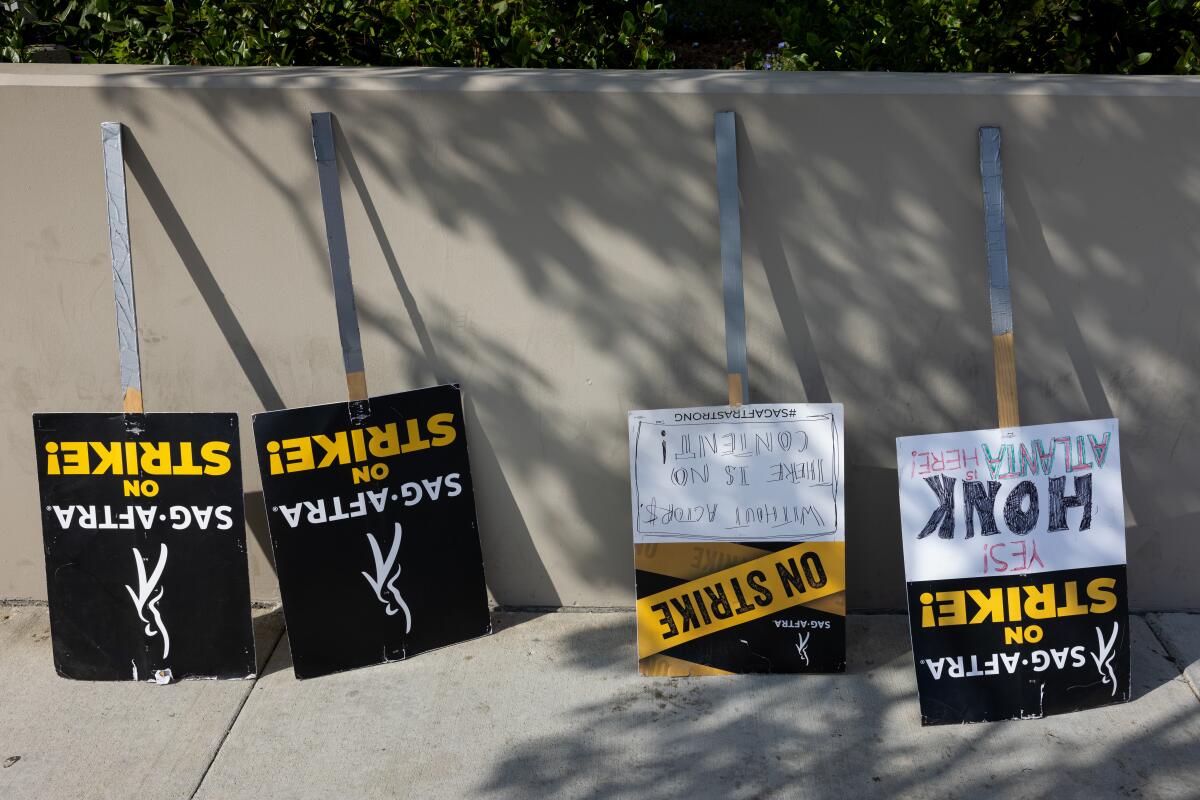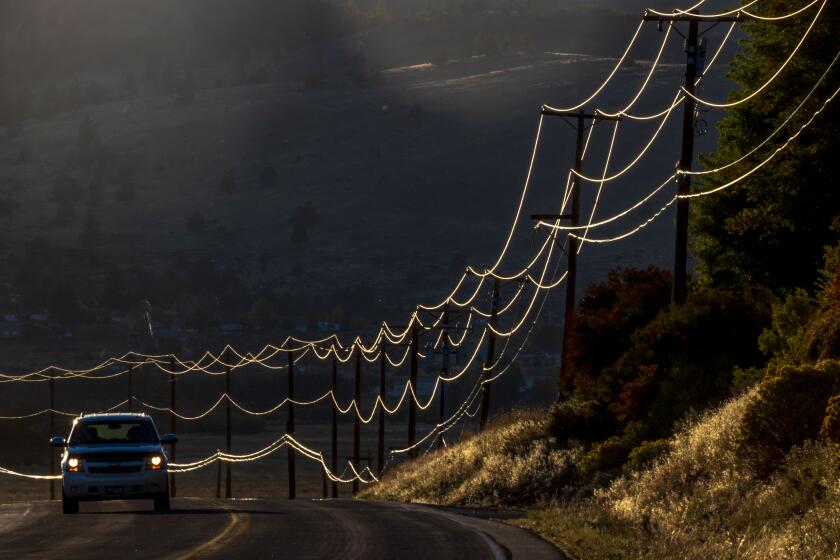Hollywood is getting back to work as SAG reaches tentative deal to end historic strike

Good morning. It’s Friday, Nov. 10. Here’s what you need to know to start your day.
- Hollywood is getting back to work as SAG reaches tentative deal to end historic strike.
- The San Gabriel Valley searches for a new normal.
- Why the world’s biggest musicians are playing casinos in the Inland Empire.
- And here’s today’s e-newspaper.
Start your day right
Sign up for Essential California for news, features and recommendations from the L.A. Times and beyond in your inbox six days a week.
You may occasionally receive promotional content from the Los Angeles Times.
Hollywood is getting back to work
As of Thursday, union actors in L.A. and across the country packed up their picket signs, marking the end of a 118-day strike after their leaders agreed to a new contract with the alliance representing major Hollywood studios.
Representatives from SAG-AFTRA and the Alliance of Motion Picture and Television Producers (AMPTP) reached a deal late Wednesday after months of contentious negotiations. The strike, along with one by Hollywood writers that began earlier (and ended in September) brought much of the Hollywood entertainment machine to a standstill.
“We have arrived at a contract that will enable SAG-AFTRA members from every category to build sustainable careers,” union officials wrote in a thread on Twitter-turned-X. “Many thousands of performers now and into the future will benefit from this work.”
So what’s in the deal? The announcement is light on details, pending review by the SAG-AFTRA National Board. The union painted some broad strokes in its celebratory thread, saying the new contract will include:
- “Above-pattern” minimum compensation increases
- “Unprecedented provisions … that will protect members from the threat of AI”
- A new “streaming participation bonus”
- “Substantially raised” caps on union pension and health plans
- Pay raises for background performers
- “Critical contract provisions protecting diverse communities”
“It’s certainly not perfect for anybody,” SAG-AFTRA national executive director and chief negotiator Duncan Crabtree-Ireland told The Times. “Any good negotiation, both parties come out of it feeling like they didn’t get everything they wanted. But I think we did get everything we needed and then some. And I think that is going to be the legacy of this negotiation.”
The union’s demands had included higher minimum pay, increased residuals for streaming shows, improved health benefits and well-defined protections against artificial intelligence’s use in filmmaking.
On the flip side, the AMPTP released a statement calling the agreement a historic “new paradigm.”
“The AMPTP is pleased to have reached a tentative agreement and looks forward to the industry resuming the work of telling great stories,” the statement concluded.
How will resuming that work look? The agreement still needs to be ratified through a vote by SAG-AFTRA’s 160,000 members before it’s official, but as of yesterday morning, actors can return to work on film and TV productions and resume promotional work on new movies and TV show seasons.
But as actor, comedian and strike captain Elyssa Phillips explained to Times reporter Christi Carras, getting back to work will look vastly different for established actors versus those who were already struggling before the work stoppage.
“The people who wait tables will still be waiting tables,” Phillips said. “They just may have auditions after work. But I’ve never been so excited to audition in my entire life.”
Actors had been on strike since mid-July after months of failed negotiations with the major studios.
While Hollywood actors (and recently writers) are now able to get back to work, Times culture columnist Mary McNamara writes that the long-term damage from the historic strikes is far from over.
“The true economic impact won’t be known for some time, but early estimates as to what the combined strikes have cost the California economy hover at more than $6 billion,” Mary wrote, noting that the number of people who found themselves out of work for months extended well beyond just actors and writers.
“How many talented people did the entertainment industry lose when the studios seemed to go out of their way to make it clear that writers and actors — and, by extension, everyone else who makes film and television — were not worth the trouble of coming up with a fair deal in time to avoid the strikes?”
Times reporters have been diligently covering the Hollywood strikes. You can explore more of their reporting on our website.
Today’s top stories

Business
- As the China-U.S. relationship fluctuates, the San Gabriel Valley faces a new normal in which it can no longer depend on Chinese tourism dollars.
- After nearly a century of earthquake vulnerability, Los Angeles’ historic General Hospital is finally being retrofitted.
- MLK Community Hospital, a crucial safety-net facility serving the South Los Angeles area, may run out of money to pay its bills as soon as next year, hospital leaders are warning.
More big stories
- Taylor Swift, SZA and maybe Morgan Wallen? Our predictions for Friday’s Grammy nominations.
- Voters sent a clear message on abortion; Republicans don’t want to hear it.
- A California agency countersues a family whose goat was slaughtered after they backed out of an auction.
- Tustin schools close after asbestos is found in the ashes from a large World War II hangar fire.
- An early season atmospheric river is expected to bring significant rain next week to Southern California.
- Some 150 people gathered at Los Angeles’ Museum of Tolerance for a private screening of graphic footage of Hamas’ attacks against Israel last month. Outside of the museum, dueling demonstrations turned violent.
- Megyn Kelly, the former Fox News star, will return to TV for the fourth debate between the Republican presidential candidates scheduled for Dec. 6 in Alabama.
Get unlimited access to the Los Angeles Times. Subscribe here.
Commentary and opinions
- Mark Z. Barabak: Newsom gets no California love for his political ambitions. Maybe he should try elsewhere.
- Michael Hiltzik: Voters, like investors, have had it with GOP extremism.
- Sammy Roth: Biden’s latest clean energy approvals are good but not enough.
- Mary McNamara: The Hollywood strikes are finally over. But we won’t repair the damage any time soon.
- JP Brammer: The lack of Latino representation in film is deeper than negligence. It’s intentional exclusion.
- Bill Plaschke: Would Clayton Kershaw and Dodgers really split? Unimaginable but understandable.
Today’s great reads
Why are the world’s biggest musicians playing casinos in the Inland Empire? Likely a seven-figure guarantee, for starters. Casinos have long been a reliable paycheck for touring musicians, but Yaamava’ Resort has upped the stakes by spending millions on A-list acts such as Ed Sheeran.
Other great reads
- Looking for a date? In Taiwan, the government is here to help.
- Candace Parker opens up on her playing career and personal life in a new documentary.
- Mo Amer’s comedy is centered on his Palestinian heritage. Now with a war, it’s hard to laugh.
- It’s a spicy Thanksgiving. Fly by Jing’s founder brings the flavors of Sichuan to her L.A. holiday Pass the mala stuffing.
- Bryce McDonald, seriously injured while serving with the Marines in Iraq, takes pride in maintaining high standards as UCLA football’s chief of staff.
How can we make this newsletter more useful? Send comments to essentialcalifornia@latimes.com.
For your downtime

Going out
- 🖼️ A Long Beach-born painter captures the surrealism of the Cambodian American experience — now on view at the Hammer Museum.
- 🐋🛥️ 18 surprising gifts for people who cherish experiences over things.
- 🌊 Angelenos who find themselves in this neighborhood may wonder if they accidentally landed in an idyllic beach town instead of an incorporated city off the 405, just south of LAX.
Staying in
- 📗 If you can stomach only one COVID closure novel, make it Michael Cunningham’s “Day.”
- 🧑🍳 Here’s a recipe for salt and Sichuan pepper dry-brined turkey.
- ✏️ Get our free daily crossword puzzle, sudoku, word search and arcade games.
And finally ... a powerful photo
Show us your favorite place in California! Send us photos you have taken of spots in California that are special — natural or human-made — and tell us why they’re important to you.

Today’s great photo is from Times photographer Irfan Khan, who captured the smoldering remains of a fire at the Marine Corps Air Station in Tustin on Tuesday. The flames destroyed the historic building, which once housed military helicopters and blimps and served as a movie backdrop.
Have a great day, from the Essential California team
Ryan Fonseca, reporter
Elvia Limón, multiplatform editor
Kevinisha Walker, multiplatform editor
Laura Blasey, assistant editor
Check our top stories, topics and the latest articles on latimes.com.
Start your day right
Sign up for Essential California for news, features and recommendations from the L.A. Times and beyond in your inbox six days a week.
You may occasionally receive promotional content from the Los Angeles Times.





